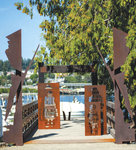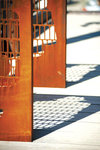

Vaughn residents Anna Brones and Luc Revel celebrated the dedication of the installation of their work at the Bainbridge Island Japanese American Exclusion Memorial in September. It is the couple’s first public art project and first artistic collaboration.
The memorial is located at the site of the former Eagledale ferry dock, where 227 Bainbridge Island men, women and children—the first of 120,000 Japanese and Japanese Americans—were forced to leave their homes 80 years ago. Two-thirds were American citizens. Despite a history on the island dating to the 1880s, they were rounded up, tagged and forced to board a ferry to Seattle. Most would be sent to Manzanar, a concentration camp in California, exiled by President Franklin Roosevelt’s Executive Order 9066 Civilian Exclusion Order No. 1.
“We learned to call them concentration and not internment camps,” Brones said. “The Nazi camps in Germany, often called concentration camps, were really extermination or death camps.”
The motto for the memorial is Nidoto Nai Yoni, “Let It Not Happen Again.” It is comanaged by the Bainbridge Island Japanese American Exclusion Memorial Association, National Park Service and Bainbridge Island Parks. The Bainbridge Island Japanese American Community provides tours of the site.
“Planning for the memorial began in 2004, with overall design under the purview of Johnpaul Jones of Jones and Jones Architects,” said Val Tollefson, president of the memorial association. “The original site plan included a story wall, completed in 2011; a reconstruction of the original ferry dock, scaled back to what we call the departure deck and completed in 2021; and a visitor center.”
“The original site plan did not anticipate artwork on the departure deck,” Tollefson said, “but once it was completed it was obvious that something was needed to explain the significance of that deck in the overall story.” The association sent out a request for proposals.
Brones, a Vaughn native, writer and artist, was intrigued. “I thought it was interesting and local. Luc encouraged me to apply. I was out of my scope in terms of visualizing space and 3-D. It was something I wanted to do but I didn’t have the language or expertise.”
Revel, who trained as an architect in Australia, filled that gap. “Space is what Luc works with as an architect,” Brones said. “And then when we talked together, we just had so many ideas. We decided we should apply together.”
They submitted their proposal in February 2021, and Brones was struck by the desire for collaboration with the community. Carol Reitz, a third generation Japanese American and president of the memorial association, was on the committee that worked with Brones and Revel. “Our goal was to elicit the emotions of people who walked the deck in 1942,” Reitz said.
“Someone on the planning committee said, ‘You shouldn’t feel good walking across that deck,’ ” Brones said. “That stuck with me. How do you create, especially in someone without a personal connection, emotions that might have been felt that day that you can portray through artwork?”
The input from the committee led to changes in the design, but key components of the initial proposal remain—the steps taken to the ferry, the dehumanizing tags the victims were forced to wear, and the use of silhouettes.
By June the couple created a mock-up to get a sense of scale and the design was completed in October 2021. Two abstract figures of soldiers flank the entry to the deck. To their right are silhouettes of a mother and child and to their left are a man and woman. A single ghost-like silhouette follows, and then the path fills with footsteps, bisected abruptly by a glass partition as the deck ends.
The initial design of the silhouettes were all ghost figures—images cut in steel panels. But that design could be a trip hazard if people tried to step through them. “We had to figure out a solution. How do you create something that has that sense of openness but isn’t actually open?” Brones said. “The solution was to use the repeating pattern of the tag shapes that creates a grid or cage. It ended up being really powerful.”
Reitz has talked to visitors about the impact of the installation. “People have tears in their eyes,” she said. Visitors step on a soundbox connecting abstract images of two soldiers at the deck entry as visitors enter the deck. That sound, said one person who had volunteered in a prison, reminded her of a prison door closing. A 12-year-old took note of the child’s silhouette—it was smaller and younger than him. The footprints of all sizes at the end of the deck makes it clear that people of all ages were taken away.
“The silhouettes,” Reitz said, “show that sometimes we don’t see people as people and don’t see the humanity. And it also indicates that people have lost who they were—they disappeared.”
“Anna and Luc’s installation is universally seen as a resounding success,” Tollefson said.
Brones and Revel said that the project took longer and was more complicated than they had anticipated, but that they are eager to do more public art.
“I don’t know of a single culture where art doesn’t play a big role. It’s hard-wired. It’s how we communicate,” Revel said.
“There is so much research about why art is important—for health and wellness, for empathy,” Brones said. “It provides a bridge that makes a connection that creates an interest, so you want to learn more. It is easy to think of artwork as superficial or a beauty thing and it is so much bigger.”
Find more information about the memorial online at bijaema.org.
UNDERWRITTEN BY THE FUND FOR NONPROFIT NEWS (NEWSMATCH) AT THE MIAMI FOUNDATION, THE ANGEL GUILD, ADVERTISERS, DONORS AND PEOPLE WHO SUPPORT INDEPENDENT, NONPROFIT LOCAL NEWS